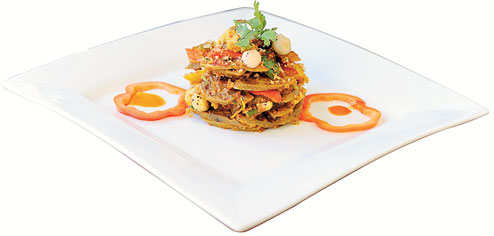-

Kamal kakri ki sabzi
I was with a friend, driving past a pond full of lotus leaves in Calcutta, when she suddenly heaved a sigh. So many would-be lotus stems, she said, and no one to eat them.
Indeed, lotus stem — called kamal kakri or bhain in the north — is a delicious ingredient that is much feted in Kashmir and the rest of the north. I have eaten it cooked in the Punjabi style, as well as the Kashmiri way — and always liked it. But in Bengal, despite the fact that the lotus flower blooms here and there, the stem doesn't figure in its cuisine.
But give it some time, says Utpal Mondal, corporate chef, Hotel Hindusthan International, Calcutta, and you'll find it on all kinds of menu. The lotus stem is eaten by some sections of the people in Bengal in any case, and may soon make its way to the high table. 'You can do great things with it,' the chef says.
That doesn't surprise me for the chef has been rustling up a kamal kakri aur akhrot ka seekh kabab (seekh kabab with lotus stems and walnuts) and a melt-in-the-mouth galouti kabab with the stem.
-

Kamal kakri aur akhrot ka seekh kabab
In Kashmir, too, the stem — called nadru — is used in kababs but figures in the usual list of vegetables as well. When prepared with red chillies, it leads to a delicious dish called nadru rogan josh, and you can cook it with curd for some nadru yakhni.
Indeed, nadru can be prepared with all kinds of ingredients. Chef Mondal, for instance, does a kamal kakri sabzi with baby corn, onion, garlic, cashew nut, roasted poppy seed, roasted almond, dry coconut and a host of spices and masalas.
Pradeep Khullar, the senior sous chef with Old World Hospitality Pvt. Ltd, which has several restaurants in India and elsewhere, many of which specialise in Kashmiri food, tells me that you have to be careful while cooking nadru because it loses colour very easily. 'If you keep it out in the open for long or if you steam it, it goes black,' chef Khullar says. 'It also has a short shelf life and goes bad very easily if you don't refrigerate it.'
The best way to cook nadru, the chef says, is by first frying it. 'And then if you steam it, it keeps its colour,' he says. Chef Mondal adds that if you soak it in vinegar water for a while, the colour remains.
The lotus stem is quite an interesting specimen. From the outside, it's nothing much to look at, but from the inside it's crisp and white and has a lovely pattern. A rhizome, it often figures in north Indian pickles. You have to carefully scrape the stem and peel it — and then cut into slices (usually diagonally, so that you can get the pattern).
The writer and cook show anchor Madhur Jaffrey has quite a few interesting lotus stem recipes to offer from the east. She cooks it with fresh tomatoes, dried ginger, fennel, asafoetida and cumin seeds in a Kashmiri Pandit style. And she steams it and then presents it in a soya sauce dressing, with rice vinegar, sugar, sesame oil and roasted sesame seeds, in an oriental dish. The dish, with regional variations, is especially popular in Korea, Japan and Hong Kong, she says.
-

Kamal kakri kay galouti kabab
'Lotus stems taste a bit like artichoke hearts though there is an edge in there somewhere,' Jaffrey writes in Eastern Vegetarian Cooking. 'Try throwing them in any stew that you are cooking.'
The good news about the lotus stem — apart from its nicely crunchy taste — is that it's very high in iron, has dietary fibres and calcium. And surely that's a good reason why it should be embraced by other cuisines?
Honey Glazed Crispy Lotus Stems with Sesame Seeds (serves 2)
Ingredients
2 lotus stems 2 cups vinegar water (2 cups water + 1 tsp vinegar) oil for deep frying 50ml honey salt to taste 10ml lemon juice 10g sesame seeds 60g cornflour
Method:
Cut the lotus stems into 1/8-inch slices. Soak the sliced stems in vinegar water for 5-10 minutes. (This will help retain its colour.) Rinse and drain well. Pat dry on paper towel — make sure that you wipe off all the liquid. Coat the stems with cornflour. Remove excess cornflour from the stems. Heat oil and deep fry the sliced stems until crispy and golden in colour. Spread on a strainer or paper towel to remove excess oil. Heat wok, add honey. When the honey gets the colour of caramel and starts bubbling, add the crispy lotus stems in it and toss. Add salt, lemon juice and the sesame seeds. Put on a serving plate and sprinkle some roasted sesame seeds on top and serve hot.












